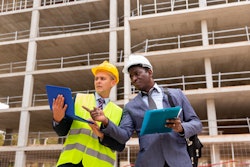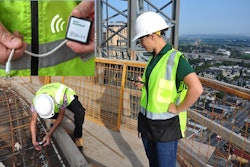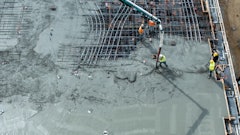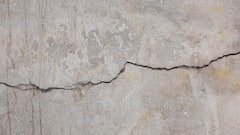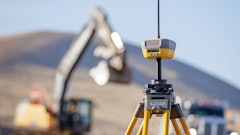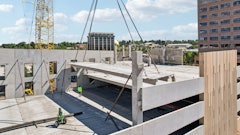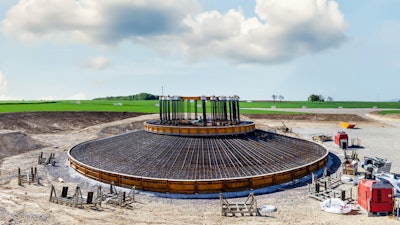
The construction industry is constantly evolving, and the use of concrete has seen significant advancements in recent years. As one of the most widely used building materials, it is crucial for contractors to find ways to improve both the productivity and sustainability of concrete. It is important for concrete professionals to be aware of the issues surrounding embodied carbon in concrete and to consider the integration of artificial intelligence (AI) and sensors to provide a solution, ultimately leading to a more efficient and sustainable construction process.
Embodied Carbon in Concrete
Concrete is an essential component in modern construction; however, its production comes with a significant environmental cost. Cement, a primary ingredient in concrete, is responsible for a large portion of embodied carbon in the material. Embodied carbon refers to the greenhouse gas emissions generated during the production and transportation of building materials, which ultimately contribute to climate change. Cement alone accounts for 8% of global embodied carbon emissions (that’s more than three times the aviation industry).
Reducing the embodied carbon in concrete is of utmost importance as the construction industry strives to minimize its environmental impact. Historically, concrete overdesign has been a common practice due to conservative design methods and lack of accurate performance data. This leads to the use of more cement than necessary, which in turn, results in higher embodied carbon levels. We believe that there is on average approximately 15% excess cement in concrete. Addressing this issue requires innovative solutions that can optimize the use of concrete without compromising its performance.  Find a significant ROI with the combination of Converge's ConcreteDNA providing contractors real-time concrete curing data and A.I. predictions with technology from DEWALT's embeddable wireless sensors.DEWALT
Find a significant ROI with the combination of Converge's ConcreteDNA providing contractors real-time concrete curing data and A.I. predictions with technology from DEWALT's embeddable wireless sensors.DEWALT
AI & Sensors
One approach to reducing the embodied carbon in concrete is to design mixes that provide just the right level of performance for various applications. For example, summer and winter mixes can be tailored to address the specific challenges posed by different climate conditions. However, achieving this level of optimization requires real-time monitoring and accurate data on concrete's performance.
This is where concrete maturity sensors and monitoring methods come into play and boost productivity. Sensors embedded within the concrete can collect data on temperature and strength development, providing valuable insights into the material's performance. By leveraging AI, this data can be used to automate concrete mix designs, making the process more efficient and scalable.
Productivity Benefits
The use of AI and sensors in concrete construction offers numerous benefits, including:
- Faster construction: Real-time monitoring enables faster decision-making, reducing the time spent waiting for concrete to reach its required strength. This translates to lower generator usage and overall energy consumption.
- More efficient use of materials: By optimizing concrete mix designs, builders can reduce waste and minimize the need for rework, leading to better quality control and resource utilization.
- Remote monitoring and safety: AI-powered sensors allow for remote monitoring of concrete, reducing the need for foot traffic on-site and enhancing overall safety.
- Less destructive testing: The use of sensors and AI for real-time monitoring can help minimize the need for damaging testing methods, preserving the integrity of the structure and reducing waste.
- Promotion of novel materials and methods: By providing scientific proof of performance using the maturity method and justifying commercial viability, AI and sensor technology can support the adoption of new materials and construction methods, driving further innovation in the industry.

What This Means for the Future
The integration of AI and sensors in concrete construction has the potential to significantly reduce the embodied carbon in concrete, leading to a more sustainable and productive industry. The large-scale implementation of these technologies could contribute to a substantial reduction in greenhouse gas emissions from the construction sector, making a notable impact on global efforts to combat climate change. For example, we estimate that simply by reducing overdesign by 15% by 2030 we could reduce embodied carbon of concrete by 400 million tonnes per annum. This is equivalent to over 1 trillion miles driven by an average gasoline-powered passenger per annum.
Continued research and development in this area are essential to drive further progress and unlock the full potential of AI and sensor technologies in the construction industry. By embracing these innovations, builders can pave the way for a more sustainable and efficient future in concrete construction.
Editor's Note: In January 2023, Converge, one of the leading concrete material and operations optimization company, and DEWALT, a Stanley Black & Decker brand and leader in total jobsite solutions, announced a strategic partnership to help decarbonize construction through Converge's AI-based platform, ConcreteDNA, powered by data from DEWALT's new wireless concrete sensor, the DEWALT Signal Sensor. Their goal is to help tackle the challenge of decarbonizing concrete to boost productivity and sustainability, as well as to bring a total solution to the DEWALT ecosystem of concrete tools.





